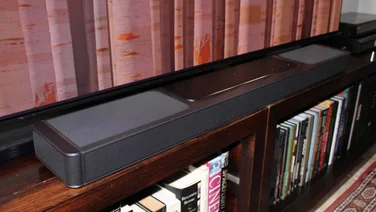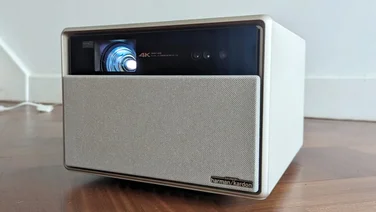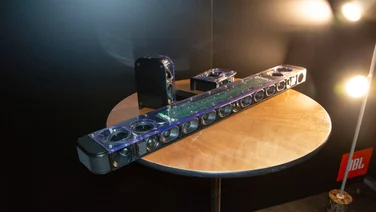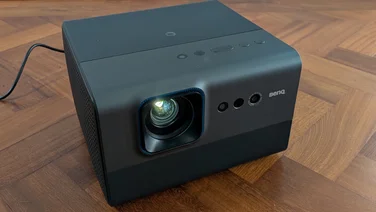To help us provide you with free impartial advice, we may earn a commission if you buy through links on our site. Learn more
















- Crazily cheap for what’s on offer
- Excellent all-round picture quality
- Wide-ranging HDR format support
- Motion isn’t the sharpest
- Minor colour striping
- Occasional detail loss in bright HDR highlights
The big attraction of the TCL C6KS is that it’s the cheapest entry in the brand’s TV range to use Mini LED backlighting. Obviously, getting Mini LEDs this cheaply means there are some pricing-related compromises to swallow, not least the fact that it has a native 60Hz panel rather than a 120Hz one. However, it retains a local dimming system, quantum dot colour and a fully formed version of Google TV smarts. So what’s the catch?
TCL C6KS review: Key specifications
| Screen sizes available | 50in (50C6KS), 55in (55C6KS), 65in (65C6KS) and 75in (75C6KS) |
| Panel type | Direct LED, with Mini LED lighting and local dimming |
| Resolution | 4K/UHD (3,840 x 2,160) |
| Refresh rates | Native 60Hz (Up to 144Hz with reduced resolution) |
| HDR formats | HDR10, HLG, Dolby Vision, HDR10+ |
| Audio enhancement | 40W Onkyo 2.1-channel speaker system, Dolby Atmos, DTS:HD |
| HDMI inputs | 3 (one with eARC) |
| Freeview Play compatibility | No |
| Tuners | Terrestrial Freeview HD |
| Gaming features | Up to 144Hz support via Dual Line Gate, ALLM, VRR, Game Bar menu |
| Wireless connectivity | Bluetooth 5.2, Wi-Fi 5, Miracast |
| Smart assistants | Works with Google Assistant |
| Smart platform | Google TV |
What you need to know
The C6KS sits in the lower half of TCL’s 2025 TV range, but still offers local dimming, Mini LED lighting, a quantum dot colour system, Google TV smarts, and some advanced gaming features. All of which looks pretty impressive in the context of a range that starts at just £389 at the time of writing for the 50in screen size I tested.
















There are significant compromises in brightness, colour range, image processing, and so on compared with TCL’s premium TVs. However, the C6KS still delivers far better results than any other similarly affordable TVs we’ve tested.
Price and competition
The C6KS comes in four screen sizes: 50in, 55in, 65in and 75in. These are priced at £389, £419, £549 and £710, respectively – all remarkably cheap for TVs that offer many mid-range features.
TCL does go cheaper still, with its P8K and recently reviewed TCL P7K ranges, with the latter starting at £249 for the 43in model. These ditch Mini LEDs in favour of regular big ones, and lose the local dimming features that have contributed so much to TCL’s TV range this year.
Other similarly affordable rivals to the C6KS are hard to find. At £360 for the 50in option, Amazon’s Fire TV Omni QLED range fits the bill, also using quantum dot colours and local dimming to deliver better pictures than you would expect for the money. Amazon’s Fire TV operating system is used on these sets rather than Google TV, of course.
Design, connections and control
While the C6KS’s extreme affordability is evident in its rather lightweight, plasticky build quality, you only really notice this during setup. It doesn’t look particularly cheap once you’re sitting at a typical viewing distance away from it. In fact, the impressively slender screen frame, with its textured black finish, creates a pleasingly crisp, clean and even mildly premium look.
While not as svelte as some of today’s TV supermodels, the C6KS is slimmer than your typical budget TV, meaning it won’t stick out too clumsily if you decide to wall mount it. The weakest link in the C6KS design is its feet. These are very basic and look and feel more plasticky compared to the rest of the TV. They’re narrow enough not to look too distracting if you’re watching the TV head-on, though.
















The C6KS is partnered with one of TCL’s more basic remote controls. This lacks the metallic finish of TCL’s more premium handsets and features a full button count rather than a stripped-back ‘smart’ layout. It’s comfortable to hold, though, and the buttons at least include a selection of quick-access buttons to popular streaming apps.
The C6KS’s connections include three HDMI ports, an Ethernet port, a digital optical audio output, satellite and RF inputs, and two USB ports (one 2.0 and one 3.0). A fourth HDMI would have been the cherry on the cake, but three isn’t an unreasonable compromise on such an affordable TV.
Smart TV platform
Using Google TV for the C6KS’s smart TV platform is a solid decision. The old issues of sluggishness and bugs that used to plague Google TV are largely resolved now, leaving you with a reasonably slick and undoubtedly content-rich experience. Plus, TCL has worked around Google TV’s usual blind spot when it comes to some UK terrestrial broadcaster catch-up apps. The BBC iPlayer, ITVX, All4 and My 5 apps are all present and correct.
















I still find Google TV a bit overwhelming in its presentation and less intelligent than some rival smart TV platforms at learning your viewing habits and making sensible recommendations. Still, it represents a great and reliable way of getting lots of content on a budget TV.
Image quality
The C6KS sets out its ambitious stall right away by pumping out a phenomenal 782cd/m2 of brightness with standard dynamic range content in its Standard picture setting. That’s way above what many TVs costing hundreds of pounds more manage, even with HDR footage. In fact, TVs at this price level seldom get beyond 250 to 350cd/m2.
Of course, injecting so much brightness into SDR content in Standard mode isn’t always a good thing. It’s no surprise, for instance, to find measurements in Standard mode using Portrait Display’s Calman Ultimate software, HDR5000 spectrometer and G1 signal generator recording greyscale and various colour scores well outside the target Delta E average error of three. Two-point and multi-point greyscale tests record Delta E average errors of 15 and 13.3, respectively, while Saturation Sweep, Luminance Sweep, and Colour Checker tests produce results of between 8.5 and 10.8.
















These aren’t crazily out of the way results, though, for what’s essentially a budget-priced TV with much more brightness firepower in its arsenal than any other TV we’ve seen in its class. Provided you can live with not seeing a very accurate picture, the Standard mode delivers far and away the most punchy, dynamic, but still engaging and believable SDR images I’ve ever seen from such a cheap TV. As well as covering more than 95% of the Rec.709 colour spectrum.
This is because the C6KS doesn’t just inject SDR images with loads of extra brightness. It’s also got the colour capabilities to ensure that both bright and subtle colours in SDR footage are amplified in line with the brightness. This ensures things don’t start to look washed out and avoids heavily saturated picture areas becoming gaudy or cartoonish. There’s a good sense of balance across the colour palette too, meaning your eye doesn’t get drawn to any excessive or unnatural tones.
















Add to all this some remarkably deep and haloing-free black levels for such a cheap TV, and you’ve got easily the most spectacular and enjoyable but also balanced and immersive SDR performance I’ve ever seen at the C6KS’s price point.
If you want accurate pictures for a lights-down movie night, the C6KS adapts to this surprisingly well. There’s no Filmmaker Mode, but the Movie mode reins in the brightness at around 333cd/m2 and pretty much halves the Delta E 2000 errors recorded by Calman Ultimate. So now Saturation Sweep, Luminance Sweep and ColorChecker tests record results of 5.3, 3.5 and 5.9, respectively, while two-point and multipoint greyscale results average out at 7.8 and 6.6.
















It’s not just the Movie mode’s more accurate measurements that make it such a great option for dark room viewing, though. It’s also a subjectively enjoyable watch for such an affordable TV, especially as the set’s excellent black levels continue to provide a near-immaculate foundation for everything else to bounce off. While still retaining high levels of shadow detail, I might add.
The picture typically looks crisp and detailed enough to feel like a proper 4K experience, even on the relatively small 50in model. The processor used to up-convert incoming HD and SD sources to the screen’s 3,840 x 2,160 pixel count is a good cut above the budget norm, leaving sharp, detail upscaled results that don’t look processed, noisy or soft.
Pretty much the only negative thing about the C6KS’s SDR pictures for their money is that motion can look a little soft, taking the edge off the generally strong sharpness. Though there’s none of the actual smearing that budget TVs can suffer from.
HDR performance
TVs as affordable as the C6KS seldom feel like they’re designed for high dynamic range playback; they’re usually not bright enough to support HDR comfortably. The C6KS feels purpose-built for HDR, though. Not least, because of its phenomenal brightness.
In the Standard HDR preset, it manages more than 1000cd/m2, 1040cd/m2 to be precise. This is ground-breaking stuff for this level of the market, and is enough to cover the full expanse of light used in many high dynamic range masters.
















The brightness drops a little in the set’s Movie mode, but only to 850cd/m2, which is still an immense figure for the price point. So in both modes, you get HDR images that don’t just look like HDR, but uncompromised HDR.
There’s always a worry with bright budget TVs that they won’t have the colour range to go with all that light. The C6KS, though, has no trouble matching its light with its colour, resulting in levels of colour volume (saturation plus brightness) that are unprecedented at this price point. Again, no colours feel too extreme or out of tonal kilter with the rest in either the Standard or Movie presets.
Maybe even more impressive than the brightness and colour vibrancy, though, is the contrast/black level performance. The equivalent models in TCL’s 2024 range struggled in this department, but the brand has fixed this with knobs on with the C6KS. Dark scenes enjoy deeper and more neutral black levels, and clouding or other distracting issues caused by the 160 zone-strong local dimming system are all pretty much non-existent.
















TCL’s new so-called HVA panels are likely key to this huge single-generation picture improvement. The panels are crammed full of innovations, including new condensed micro lenses that improve backlight uniformity, a new Micro Optical Distance structure that reduces the potential for the light coming from the rear lighting array to become diffused, and a new ‘butterfly wing-shaped’ liquid crystal molecular microstructure that offers much more precise control of the liquid crystal layer.
Also doubtless playing their part are the impressive number of dimming zones the C6KS uses (from 160 in the 50in to 312 in the 75in), and seemingly much improved backlight control processing.
The impressive colour range and volumes apparent in SDR are unsurprisingly even more evident with HDR footage. Calman Ultimate tests record TCL’s TV covering 93.4% of the DCI-P3 colour spectrum, and even at peak brightness, the colours don’t suffer with any significant loss of saturation.
















In the most vibrant-looking and brightest Standard HDR preset, the push for punch results in some easily measurable deviations from the HDR picture standards. Delta E average errors hit 12.5 on Calman Ultimate’s ColorMatch HDR test and 15.8 on a ColorChecker Analysis test, though these drop to 7.7 and 7.8 with luminance errors removed from the equation.
As with SDR, though, these measurable errors don’t add up to a subjectively distractingly imbalanced or off-key colour performance. On the contrary, the vibrancy and punchiness of the Standard mode’s HDR pictures are hugely enjoyable.
Perhaps the biggest revelation about the C6KS’s entire performance is how great its Movie mode looks while also pivoting to more accurate images. Delta E average errors with ColorMatch HDR and ColorChecker HDR tests in Movie mode fall to 7.7 and 4.5, both closer to the three error level AV perfectionists are looking for than the vast majority of similarly affordable TVs get. Yet, as well as getting pretty close to objective accuracy, the HDR Movie mode image is still subjectively rich in contrast, vibrant and punchy rather than flat, washed out and drab.
















Inevitably, the C6KS isn’t a perfect HDR performer. There can be a trace of colour banding over subtle colour blends, and the very brightest highlights of HDR images can occasionally lose a little shading detail. Motion continues to lose a touch of resolution with native 4K HDR sources, which none of the provided motion processing tools fully fix.
The Dolby Vision Dark preset can be a bit heavy-handed, resulting in some subtle details getting crushed out of the darkest picture areas, though this doesn’t matter too much, since the Dolby Vision Bright preset works just fine.
















The picture can desaturate a little if you have to watch it from an angle, too, and finally, you should be prepared to put in a bit of legwork if you want to ensure pictures always look their best. Particularly worthwhile tweaks are toning down the potency of the Dynamic Tone Mapping system, upping the warmth level of the default colour settings to stop things looking a little ‘cool’ out of the box, and nudging down the strength of the default motion processing settings in Standard mode.
To test the TCL C6KS, I used Portrait Displays Calman colour calibration software.
Gaming
The C6KS can’t be considered a true gaming TV due to its native 60Hz refresh rate, but it is a strong option for the money. The HVA panel helps it deliver punchy, bold images even after its Game mode has turned off/reduced some of the screen’s picture enhancement tools to keep input lag low. And when I say low, I mean it: tests with a Leo Bodnar test meter record just 9.9ms of lag with 60Hz titles in Game mode. That’s among the lowest figures I’ve seen from a TV, ensuring that gaming feels satisfyingly crisp and responsive.
















The extreme brightness by budget TV standards helps deliver far more of the increasingly dynamic and extreme use of light offered by today’s AAA HDR games, too. Meanwhile, the Game Master system for sacrificing resolution to gain refresh rates higher than the screen’s native 60Hz works decently well in terms of creating a more fluid movement and panning experience. That said, I found the sacrifice of resolution required to accelerate the frame rate a bit hard to take, at least with some of the prettiest high frame rate titles.
Motion still looks a touch soft at 60Hz, despite the panel delivering improved transient response, and colours look slightly less richly saturated in the fastest responding Game mode than they do in other presets. Provided you’re OK sticking with 60Hz for the most detailed graphics, though, the C6KS is a far better gaming performer than most of its similarly priced rivals.
Sound quality
The C6KS’s theme of substantially overperforming for its price continues with its sound. For starters, it can go startlingly loud without the speakers becoming strained or distorted, even when reworking Dolby Atmos and DTS Virtual:X soundtracks into its relatively limited 2.1-channel count.
















This combination of power and clarity results in an impressively detailed soundstage that really brings busy, complex movie and TV sound mixes to life. I heard subtle sound effects emerging from the C6KS that many far more expensive TVs fail to register. The TCL/Onkyo speakers even manage to project sound a decent distance away from the screen without the resulting relatively large sound stage starting to sound fragile, thin or unbalanced. On the contrary, sound effects are placed quite accurately within the soundstage.
The only obvious flaw with the sound is that it doesn’t go very deep in pursuit of the bass element of its sound configuration. I’m not saying there’s no bass at all, but there certainly isn’t enough to add major heft or power to heavy movie soundtrack rumbles or impact sounds. This can cause some treble sounds to appear a little over-exposed, too. The good news is that what little bass there is isn’t affected by crackles, dropouts or other distortions, suggesting that TCL has sensibly opted to keep the sound operating well within the speakers’ physical limits.
Verdict
TCL’s C6KS series proves emphatically that the brand’s ability to deliver phenomenal bang for your buck isn’t restricted to its premium TV models. Despite its ultra-affordable pricing, it retains Mini LED lighting, uses one of TCL’s new HVA panels, delivers more local dimming light control zones than many TVs costing twice as much, and offers a more far-reaching range of gaming features than you’ve any right to expect for so little money.
Even better, the C6KS puts all of its features to excellent use, delivering a level of picture and sound performance that’s nothing short of ground-breaking for the money.







